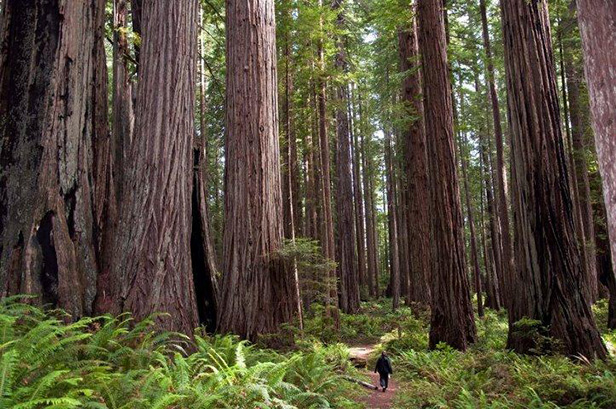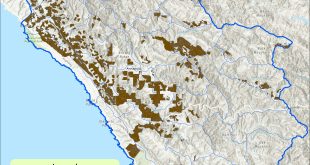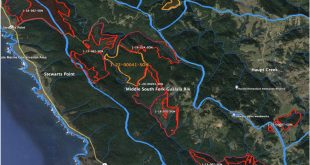Excerpted from “The effects of timber harvest versus forest protection in JDSF [Jackson Demonstration State Forest]” by John O’Brien, PhD.
Dr. O’Brien has a doctorate in climate and atmospheric science from U.C. Santa Cruz, and lives adjacent to JDSF, but his comments on logging and climate change are relevant to similar redwood forest lands on the northern California Coast.
Executive Summary
Short of burning fossil fuels, cutting down trees is the single worst thing we can do for climate change. Not only do trees directly remove CO2 from the atmosphere and store it for centuries to millennia, the very act of cutting them down results in immediate carbon releases via felling, hauling, milling, and processing machinery that represents a “double hit” to the climate. Climate change presents a clear, present, and ever increasing danger to nearly every aspect of our lives and the earth system, including our terrestrial forests. The overwhelming body of scientific evidence indicates that forest mortality will drastically increase in the future with conifer species being disproportionately affected (McDowell and Allen, 2015). Agents of change include but are not limited to water and temperature stress, insects and pathogens, wildfire, logging, and urbanization to name a few.
. . .
The continued logging in JDSF presents a tremendous lost opportunity to protect biodiversity, mitigate climate change, generate revenue, restore endangered species habitat, reduce wildfire risk, remedy social injustice, and conduct meaningful science aimed at saving our forests and planet. Selected key take-aways from the research conducted herein are summarized below and expanded on in the body of this letter.
- The largest trees in any forest are also the most fire resilient and their selective removal weakens the forest’s resilience as a whole to wildfire (Douglas et al. 2010).
- Selectively logging the largest trees opens the forest canopy allowing more solar radiation to reach the forest floor thereby drying out the underbrush and soils creating hotter, drier, and more flammable understory microclimates (Weatherspoon, 1996).
- Selectively logging the largest trees thins the canopy and stand allowing for greater in-canopy and in-stand wind speeds that fuel higher intensity fires (Banerjee, 2020).
- Across the entire western U.S., fires burned with less intensity on lands that had the highest protections from logging (Bradley et al., 2016).
- Weather and climate is the most important predictor of wildfire intensity with logging intensity being the second most important factor (Zald and Dunn, 2018).
- The largest atmospheric driver of wildfire intensity, Vapor Pressure Deficit, has and will continue to exponentially increase with continued climate warming (Williams et al., 2019).
- Climate change in California will be characterized by a hydroclimate with a greater probability for drought conditions interspersed with sharper, more intense rainy seasons (Swain et al., 2018).
- Forest mortality resulting from drought and temperature stress is expected to increase dramatically in the future with disproportionate effects to conifer species (McDowell and Allen, 2015).
- Climate change disproportionately affects species in regions of high endemic biodiversity like JDSF making them 3-10 times more likely to suffer negative effects (Manes et al., 2021).
- The economic potential from protecting JDSF through recreation and carbon sequestration far outweighs the monetary value of timber extraction.
- Mature second growth Redwoods are now more rare than old growth Redwoods due to the lack of any kind of protections for these trees (Burns et al., 2018).
- Timber harvesting is the largest emitter of CO2 of any natural or human-caused forest disturbance type (Harris et al., 2016).
- Limiting timber harvesting and increasing forest protection on public lands is the best approach to increase forest carbon uptake ( Law et al., 2018).
- Increasing forest protection is the lowest cost and the single most effective tool we have in meeting emission reduction targets (Moomaw, et al., 2019).
. . .
Read Dr. O’Brien’s complete 26-page letter, “The effects of timber harvest versus forest protection in JDSF.”

 Friends of Gualala River Protecting the Gualala River watershed and the species living within it
Friends of Gualala River Protecting the Gualala River watershed and the species living within it


